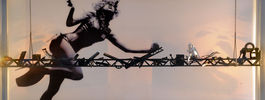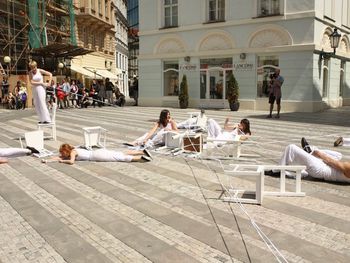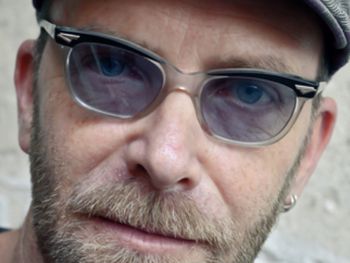PQ 2015
Hot News
THE INTERNATIONAL EXHIBITION: Countries and Regions
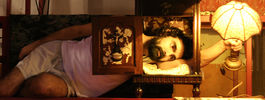
An exhibition of a thousand theatre artists from 60 countries and regions.
SHAREDSPACE 2013- 2016
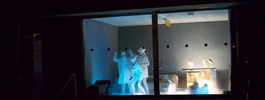
Art and research project presents symposiums, workshops or exhibitions in 11 countries.
OBJECTS
Objects and their stories – this is the main theme of “Objects”, an exhibition open to individual artists.

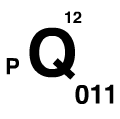
1975 » German Democratic Republic » Stage and costume design
| Curator: | Günter Riegel |
NĚMECKÁ DEMOKRATICKÁ REPUBLIKA
Scenarist of the exhibition: Friedrich Dieckmann The exposition of the German Democratic Republic at the 1975 Prague Quadrennial again attempts to provide an insight into the working methods of the art of stage designing, which aims at a close alliance with the work of the director. The concept of the stage designer as "co-director", who does not endeavour to build impressive decorations for the work of the director and the actors, but develops the sets from the characters and their arrangement, founded by Brecht, and developed in an exemplary manner by the work of Karl von Appen at the Berliner Ensemble, should also be evident in the present exposition. Building on this foundation, a number of young stage designers, almost all of them the former students of Karl von Appen and the unforgotten chief designer of the Deutsches Theater, Heinrich Kilger, have placed new accents in their work during the past few years. In spite of an evident diversity in their means and methods, they have one common approach: a rejection of rigid, solid decorations and a stress on mobile, dynamic forms, which are part of the endeavour to achieve a direct and dynamic relationship with the audience. Thus in different ways, these artists are helping to shape a contemporary form of stage realism - because realism must be formulated for each generation anew – which reflects our constantly changing reality. In 1971 the exposition of the GLR was quite extensive and this made it possible to divide it into various genres /drama, opera, ballet, etc./ and within these genres a chronology of playwrights, poets and composers. Our contribution to the present, third Prague Quadrennial is smaller in size and places greater stress on stage designers as such; the exposition organises the designs according to their authors. Larger complexes are the result of the fact that the artists are often members of a particular theatre. Thus recent work done at the Volksbühne in Berlin forms a separate complex, which gives a survey of the activities of this particular theatre during recent years. Smaller complexes concern the two Berlin Opera Houses /Deutsche Staatsoper and the Komische Oper/ and the theatresin the cities of „Magdeburg and Potsdam, Karl-Marx-Stadt and Leipzig. But even very small theatres in such towns as Rudolstadt /with a population of 28 000/ or Meiningen /with 24 000 inhabitants/are represented with the work of their stage designers. Thus, hopefully, the exposition also provides a sort of cross-section of stage designing in our country.
Exhibiting artists / ateliers
[show all | hide all]- Eberhard KEIENBURG
- George Bernard Shaw: (Mrs. Warren's Profession), Berliner Ensemble 1973, Director: W. Pintzka,
- George Bernard Shaw: (Arms and the Man), 1975, Director: W. Weit,
- Bertolt Brecht: (The Didactic Play of Baden ), Berliner Ensemble 1973, Director: J. Pörschmann, G. Schmidt,
-
Bertolt Brecht: (Turandot),
Berliner Ensemble
1973, Director: P. Kupke, W. Pintzka,
- Günther Altmann
-
Georg Büchner: (Danton's Death),
1973, Director: K. Zschiedrich,
-
Williame Shakespeare: (Hamlet),
1973, Director: W. Fresse,
- Karl von Appen
-
Carlo Goldoni: (Country Life),
Deutsches Theater Berlin
1974, Director: W. Heinz,
-
Jules Massenet: (Manon),
Deutsche Staatsoper Berlin
1971, Director: H. Bonnet,
-
Bertolt Brecht: (Turandot),
Berliner Ensemble
1973, Director: P. Kupke,
-
George Bernard Shaw: (Mrs. Warren's Profession),
0
- Hans Brosch
-
Heinrich von Kleist: (The Prince of Homburg),
Deutsches Theater Berlin
1975, Director: A. Dresen,
-
Heinrich von Kleist: (The Broken Jug),
Deutsches Theater Berlin
1975, Director: A. Dresen,
- Manfred Grund
- : (Adam and Eve), 1973
-
Bertolt Brecht: (The Days of the Commune),
0
-
Pablo Neruda: (The Life and Death of Joaquin Murieta),
1974, Director: H. Fischer,
- Franz Havemann
-
B. Jonson: (Bartholomew Fair),
1972, Director: F. Bennewitz,
- : (The Threepenny Opera), 1973
-
J. W. Goethe: (Faust),
1975
- Pieter Hein
- Friedrich Schiller: (The Robbers), Volksbühne Berlin 1971, Director: M. Karge, M. Langhoff,
-
Henrik Ibsen: (The Wild Duck),
Volksbühne Berlin
1973, Director: M. Karge, M. Langhoff,
-
Moliere: (The Misanthrope),
Volksbühne Berlin
1973, Director: F. Marquardt,
-
: (Frühe Fassungen),
0
- Otto Kähler
- Hans Helmut Müller
-
H. Müller, I. Müller: (Women's comedy),
Volksbühne berlin
1971, Director: F. Marquardt,
- Bernhard Schröter
-
Friedrich Schiller: (Wallenstein),
1974, Director: K. Kayser,
- Falk von Wangelin
-
M. P. Musorgskij: (Boris Godunov),
Deutsche Staatsoper Berlin
1972, Director: E. Fischer,
- Wilfried Werz
- : (Evgeni Onegin), Deutsche Staatsoper 1975
-
: (Carmen),
Komische Oper Berlin
1972, Director: W. Felsenstein,
-
Giuseppe Verdi: (Otello),
Deutsche Staatsoper Berlin
1972, Director: H. Kupfer,
-
Krzysztof Penderecki: (The Devils of Loudun),
Deutsche Staatsoper Berlin
1975
- Ralf Winkler
-
V. Braun: (Hinze and Kunze),
1973, Director: P- Drescher,
-
S. O'Casey: (Red Roses for Me),
1973, Director: P. Drescher,
- Reínhart Zimmermann
- : (The Marriage of Figaro), Komische Oper 1975
-
Jaques Offenbach: (The Tales of Hoffmann),
Det Norske Opera
1974, Director: P. Fosser,
-
A. Berg: (Lulu),
Komische Oper berlin
1975, Director: J. Herz,
- Annemarie Rost
-
J. W. Goethe: (Götz of Berlichingen),
Deutsches Theater Berlin
1974, Director: H. Schönemann,
- Gerhard Arnold
-
E. Weiner: (Csongor and Tünde),
1974, Director: F. Sladeček,
- Frank Borisch
- : (Danton's Death), 1973
-
Friedrich Schiller: (Fiesco or the Conspiracy of Genos),
1971, Director: W. Freese,
- Christiane Dorst
-
Giuseppe Verdi: (Falstaff),
Meiningen
1972, Director: W. Séranky,
- Alwin Eckert
-
Eugeny Schwarz: (The Ordinary Miracle),
1972, Director: H. Albiro,
- Jochen Finke
-
Friedrich Schiller: (Intrique and Love),
Kammerspiele
1972, Director: K. Erforth, A. Stillmark,
- S. O'Casey: (Juno and the Paycock), Kammerspiele 1972, Director: A. Dresen,
- : (False Money), Kammerspiele 1974
- Lothar Scharsich
- Friedrich Schiller: (Intrique and Love), 1972, Director: Elke Wiegand,
-
V. hovo-Kobylin: (Tarelkin's Death),
1971, Director: Th. Valentin,
-
E. Lessing: (Nathan the Wise),
1971, Director: Th. Vallentin,
-
K. Mickel: (La Celestina),
Berliner Ensemble
1974
- Christine Stromberg
- Williame Shakespeare: (The Tempest), Deutsches Theater berlin 1974, Director: F. Solter,
- Volker Walther
-
V. Braun: (The Tippers),
1972, Director: H. D. Maves, D. Roth,
- H. Müller, I. Müller: (Women's Comedy), Theater der Bauschaffenden 1972, Director: A. Eicke,
- Fritz Werner
- : (A Midsummer Night's Dream), 1973
-
Maxim Gorkij: (The Lower Depths),
1972, Director: K. Krampe,
- Siegfried BACH
-
George Gershwin: (Porgy and Bess),
1971, Director: G. Imbiel,
- Wolfgang BELLACH
-
Sofokles: (Antigone),
1972, Director: P. Drescher,
- Kristina BIEDERMANN
-
Jean-Baptiste Molière: (Tartuffe),
1972, Director: D. Roth,
- Helga BORISCH
-
R. Kuhnert: (Rumpelstilzchen),
1973, Director: G. Reyer, R. Kuhnert,
- Helmut BRADE
- : (The Beautiful Helen), Volksbühne Berlin 1972
-
I. Örkény: (Play of Cats),
Volksbühne Berlin
1974, Director: B. Soubeyran,
-
Jean Racine: (Britannicus),
Volksbühne Berlin
1975, Director: B. Soubeyran,
- Heidi Brambach
- Wasja GÖTZE
-
E. Köhler: (The Ghost of Cranitz),
Volksbühne Berlin
1972, Director: E. Marquardt,
- : (The Golden Elephant), Volksbühne Berlin 1972
- Christa HAHN
- Peter HEILEIN
-
Wolfgang Amadeus Mozart: (The Magic Flute),
Hans-Otto-Theater
1974, Director: P. Brähmig,
-
Bertolt Brecht: (Schweik in the Second World War),
Hans-Otto-Theater
1971, Director: Neubauer,
-
P. Hacks: (Amphitryon),
Deutsches Theater
1972, Director: F. Solter,
- Peter HOPPE
-
M. de Falla: (The Three-Cornered Hat),
Deutsche Staatsoper
1972, Director: H. Rudolf,
- Johanna KIELING
- Bertolt Brecht: (Master Puntila and His Man Matti), Berliner ensemble 1974, Director: P. Kupke,
- Dieter KLASS
-
E. Eschner: (King Jörg),
1974, Director: Ch. Bleyhoeffer,
- Bernd LEISTNER
-
Leoš Janáček: (Jenufa),
Landestheater
1973, Director: H. Runge,
- Harald METZKES
- Moliere: (A Doctor in Spite of Himself), Volksbühne Berlin 1970, Director: B. Besson,
- Edda NAUMANN-COLDITZ
-
Aristophanes Aristofanés: (The Peace),
Staatstheater Schwerin
1971, Director: G. Schareck,
-
E. Rostand: (Cyrano de Bergerac),
Staatstheater Schwerin
1971, Director: A. Eicke,
- Einar SUHLEEF
- E. Strittmatter: (Katzgraben), Berliner Ensemble 1972, Director: B. K. Tragelehn, L. Schleef,
- F. Wedekind: (Spring's Awakening), Berliner Ensemble 1974, Director: B. K. Tragelehn, E. Schleef,
- August Strindberg: (Miss Julie), Berliner Ensemble 1975, Director: B. K. Tragelehn, E. Schleef,
-
Tirso de Molina: (Don Gill),
Volksbühne Berlin
1972, Director: B. Soubeyran,
- Jochen SCHUBE
-
Bertolt Brecht: (Saint Joan of the Stockyards),
1974, Director: G. Müller,
- Günter THIELMANN
-
Eugeny Schwarz: (The Snow Queen),
1973
- Ezio TOFFOLUTTI
-
P. Hacks: (Margaret of Aix),
Volksbühne Berlin
1973, Director: B. Besson,
- A. Müller: (The Last Paradise), Volksbühne Berlin 1973, Director: B. Besson,
-
Carlo Gozzi: (Das Schöne grüne Vögelchen),
Volksbühne Berlin
1975
- Gertraud TÖPFER-STOJANTSCHEW
- H. Sekyrková: (The Adventures of Little Lion), Puppentheater Magdeburg 1972, Director: G. Reyer,
- I. Creanga, V. Harz: (The Little Purse With Twenty Pennies), Puppentheater Magdeburg 1975, Director: G. Reyer,
- Gero TROIKE
- Gabriele KOERBL
-
P. Hacks: (Amphitryon),
Deutsches Theater Berlin
1972, Director: F. Solter,
-
A. P. Čechov: (The Seagull),
Hans-Otto-Theater
1973, Director: R. Winkelgrund,
- Eleonore Kleiber
-
Wolfgang Amadeus Mozart: (The Marriage of Figaro),
Komische Oper Berlin
1975, Director: W. Felsenstein,
Specialization: set designer
Additional information: Born in 1936 in Leipzig. Since 1974 first stage designer at the German
Theatre in Berlin. He participated in the PQ in 1967, 1975 and in 1979.
Exhibiting works
Additional information: Born in 1933 in Gorlitz. He studied at the School for Applied Arts in Leipzig. He worked for the Municipal Theatre in Greiz and Bautzen and for the Kleist Theatre in Frankfurt am Oder. Later he was the chief designer at the State Theatre in Schwerin. He has for a number of years been and is also at present the chief stage designer of the Municipal Theatres in Magdeburg. He participated in the Prague Quadrennial in 1967.
Exhibiting works
Additional information: Born in 1900 in Düsseldorf. In the years 1920 - 1924 he studied painting and graphics under F.K. Delaville at the Academy of Arts in Frankfurt am M. Since 1926 he worked in Berlin and since 1929 in Dresden. In 1933 he was barred from professional activities by the Nazis and in 1941 - 1945 he was a prisoner in a concentrations camp for his illegal political activities. In 1945 - 1954 he was the chief stage designer at the State Theatre at Dresden and in 1947-49 he was the theatre' s superintendent. He is the founder and chief of the department of stage design at the Academy of Fine Arts in Dresden. Since 1954 he is the chief stage designer of the Berliner Ensemble, where he has collaborated with stage directors Bertolt Brecht, Benno Besson, Erich Engel, Fritz Kortner, Peter Palitsch, Joachim Tenschert, Manfred Werkwerth and others. In 1960 he became a full professor and in 1961 a member of the German Academy of Art. In 1956 and 1969 he received a State Prize of the German Democratic Republic and in 1975 he received the Order of Karl Marx. He participated in the Prague Quadrennial in 1967, in 1971 and in 1975; he received the PQ Gold Medal in 1967.
Exhibiting works
Additional information: Born in 1943 in Berlin. He first worked in a printing shop, later he became a student of and later assistant to Karl von Appen at the Berliner Ensemble. At present he is the stage designer of the German Theatre in Berlin. He participated in the Prague Quadrennial in 1967 and in 1975.
Obrázky z kataloguExhibiting works
Additional information: Born in 1929 in Dresden. In the years 1948 - 1954 he studied under Karl von Appen at the Academy of Fine Arts in Dresden. After graduation he worked in Zittau, in the Berliner Ensemble and as chief stage designer of the Berlin Volksbühne. In the years 1971 - 1974 he was a free lance designer and during 1974 - 1977 he was at the State Theatre in Dresden. Since 1977 he is the deputy chief designer at the Berliner Ensemble. He parti - cipated in the Prague Quadrennial in 1967, in 1971 and in 1975.
Obrázky z kataloguExhibiting works
Additional information: Born in 1933 in Neukloster (Mecklenburg). Since 1963 he is the chief stage designer at the German National Theatre in Weimar. He partici- pated in the PQ in 1967, 1971, 1975 and in 1979.
Obrázky z kataloguExhibiting works
Additional information: Born in 1939 in Berlin. In the years 1956 - 1960 he studied at the Academy of Graphic Art at Berlin- Charlottenburg with prof. Willi Schmidt. After graduation he worked at Quedlinburg and at the Berlin Volksbuhne. He became a student of Karl von Appen at the Academy of Art in Berlin and in the years 1964 - 1969 he was at the Berliner Ensemble. He participated in the Prague Quadrennial in 1967, in 1971 and in 1975.
Obrázky z kataloguExhibiting works
Additional information: Born in 1910 in Lübeck. He was originally a cabinet maker in a theatrical workshop. Later he became a stage designer in Brieg and Güstrow. In the years 1945 - 1948 he was superintendent at the Municipal Theatre at Güstrow, in 1948 - 1950 the chief of all workshops at the Mecklenburg State Theatre in Schwerin. In 1950-1953 he worked in adult education in the local administration in Berlin, in the years 1953 - 1959 he was the chief stage designer at the Hans-Otto Theatre in Potsdam and in 1959-1977 the chief stage designer at the Friendship Theatre in Berlin . In 1966 he received a State Prize of the G. D. R. /as a member of a collective/ and in 1975 he received the Critics Award of the journal Berliner Zeitung. Since 1967 he is a member of the stage design commission of OISTT and since 1975 president of the OISTT section in the German Democratic Republic and chairman of an ad hoc committee on stage design. He participated in the Prague Quadrennial in 1967, in 1971 and in 1975.
Obrázky z kataloguAdditional information: Born in 1930 in Schwerin. He worked as a teacher and studied at the School of Arts and Crafts in Wismar in Mecklenburg, where he graduated in 1954. Between 1954 and 1958 he studied painting at the Academy of Fine and Applied Arts in Berlin-Weissensee. From 1958 to 1961 he was assistant to Rudolf Heinrich at the Komische Oper in Berlin, and later became a stage designer at this theatre. He participated in the Prague Quadrennial in 1967.
Obrázky z kataloguExhibiting works
Additional information: Born in 1928 in Breslau, where he studied at the School of Applied Art under architect and stage designer Hans Haueisen-Courath. He worked as stage designer in the Municipal Theatres of Karl-Marx-Stadt and for the Municipal Theatres of Leipzig. Among his most interesting work are the stage sets for Maria Stuart, Macbeth, Cabal and Love, Carmen, The Magie Flute, Swan Lake, The Prodigal Son and Orpheus and Euridice. He participated in the Prague Quadrennial 1967.
Obrázky z kataloguExhibiting works
Additional information: Born in 1939 in Guhlau. In the years 1959 - 1964 he studied at the Academy of Fine Arts in Dresden under prof. Reicherd. He has worked for theatres in Rostock, Halberstadt and Dresden. At present he works as a stage designer in the Volkstheatre in Rostock. He participated in Prague Quadrennial in 1967, in 1971 and in 1975.
Exhibiting works
Additional information: Born in 1930 in Dresden. Since 1965 he is the chief stage designer at the State Opera in Berlin. He participated in the PQ in 1967, 1971, 1975 and in 1979.
Obrázky z kataloguExhibiting works
Additional information: Born in 1936 in Chemnitz /Karl-Marx-Stadt/, during 1954-57 he was an apprentice, learning the craft of set painter in the Municipal Theatres in Karl-Marx-Stadt. Between 1957-1962 he studied under prof. Heinrich Kilger at the Academy of Fine and Applied Arts in Berlin-Weissensee. From 1962 to 1964 he was a stage designer in the Municipal Theatre in Leipzig, from 1964 to 1967 chief designer at the Hans-Otto-Theater in Potsdam. Since 1967 he has been the chief designer at the Municipal Theatres in Karl-Marx-Stadt. He participated in the Prague Quadrennials in 1967 and in 1971.
Obrázky z kataloguExhibiting works
Additional information: Born in 1936 in Erfurt. Since 1962 he is the chief stage designer at the Komische Oper in Berlin. He participated in the PQ in 1967, 1971, 1975 and in 1979.
Obrázky z kataloguExhibiting works
Additional information: Born in 1924 in Dresden. In the years 1947 - 1951 she studied at the Academy of Fine Arts in Dresden with Karl von Appen . She made her debut in the Berliner Ensemble and then worked in the Maxim Gorki Theatre and in the German Theatre in Berlin . Since 1976 she is the chief of the costume department of the Berliner Volksbühne. She participated in the Prague Quadrennial in 1971 and in 1975.
Exhibiting works
Additional information: Born in 1939 in Aue. He was assistant to Otto Kahler at the Hans-Otto-Theater in Potsdam; between 1959 and 1961 an assistant stage designer at the Volksbühne in Berlin, under Roman Weyl. Between 1961 and 1969 he was a stage and costume designer at the Volkstheater in Rostock, from 1966 to 1967 at the Municipal Theatres in Magdeburg and after 1967 at the Friendship Theatre /a theatre for children and youth/. At present he is the chief designer of the Municipal Theatre in Rudolstadt. He participated in the Prague Quadrennial in 1971.
Obrázky z kataloguExhibiting works
Additional information: Born in 1941 in Dresden. He studied at the Academy of Fine Arts in Dresden, where he graduated in 1965. After graduation he worked at the Friedrich-Wolf-Theater in Neustrelitz. Since 1968 he is a stage designer at the Municipal Theatres in Magdeburg. He participated in the Prague Quadrennial in 1971.
Obrázky z kataloguExhibiting works
Additional information: Born in 1939 in Babelsberg. Between 1957 and 1962 she studied at the Academy of Fine and Applied Arts in Berlin-Weissensee under prof. Heinrich Kilger. Between 1962 and 1968 she was a stage and costume designer at the Hans-Otto-Theater in Potsdam. In 1968 she became costume designer at the Municipal Theatres in Leipzig. At present she is a costume designer for the DEFA film company in Potsdam-Babelsberg. She participated in the Prague Quadrennial in 1971.
Obrázky z kataloguExhibiting works
Additional information: Born in 1937 in Pazuchy in Poland. He first completed his apprenticeship as a house-painter and in the years 1956 - 1959 studied at the Vocational School of Applied Arts in Leipzig.Later he worked as a set painter and as an assistant designer . In the years 1965 - 1970 he studied at the Academy of Fine and Applied Arts in Berlin-Weissensee under prof. Kilger. After graduation he worked at Karl-Marx-Stadt and at Potsdam and since 1976 he is a free lance stage designer. He participated in the Prague Quadrennial in 1971 and in 1975.
Obrázky z kataloguExhibiting works
Additional information: Born 1941 in Glogau. Since 1980 he has been working as chief stage designer at the Volksbűhne Theatre in Berlin. He participated in the Prague Quadrennial in 1971, 1975, 1979 and 1987.
Obrázky z kataloguExhibiting works
Additional information: Born in 1939 in Berlin. He was a student with and since 1970 an assistant to prof. Karl von Appen at the Berliner Ensemble. He graduated from the Academy of Fine and Applied Arts at Berlin-Weissensee. His diploma work - the stage and costume designs for Regina B. by Siegfried Pfaff - was realised at the Maxim-Gorki-Theater in Berlin. Since then he has undertaken stage designs for theatres in Prenzlau, Brandenburg and Neustrelitz. During 1974 and 1975 he has been working for the Volksbühne and for the Kammerspiele in Berlin. He participated in the Prague Quadrennial in 1971.
Exhibiting works
Additional information: Born in 1928 in Bydgoszcz. Between 1948 and 1950 she studied at the Academy of Fine Arts in Weimar, between 1951 and 1955 at the Academy of Fine and Applied Arts at Berlin-Weissensee, under prof. Heinrich Kilger. At present she is chief of the costume department of the German State Opera in Berlin. She has undertaken numerous costume designs for this theatre, for the Deutsches Theater in Berlin and for the Berliner Ensemble. She participated in the Prague Quadrennial in 1971.
Obrázky z kataloguExhibiting works
Additional information: Born in 1939 in Kiederau near Meissen. Between 1959 and 1964 he studied at the Academy of Fine Arts in Dresden. Between 1964 and 1967 he was a stage designer at the theatre in Stendal, at the Mecklenburgisches Staatstheater in Schwerin, at the Municipal Theatres in Magdeburg and at the joint Theatre of Görlitz and Zittau. He has designed stage sets for theatres in Leipzig, Karl-Marx-Stadt, Halle, Stralsund, Frankfurt an der Oder and for television in the German Democratic Republic. At present he lives in Gorlitz. He participated in the Prague Quadrennial 1971.
Obrázky z kataloguExhibiting works
Additional information: Born in 1924 in Berlin. After 1945 he studied painting and graphic art. In 1950 he became an assistant stage designer in Gera and subsequently stage designer at theatres in Rudolstadt, Greiz and Cottbus. At present he is the chief stage designer of the Municipal Theatre in Plauen /Vogtland/. He participated in the Prague Quadrennial in 1971.
Obrázky z kataloguExhibiting works
Additional information: Born in 1928 in Annaberg. He studied at the School of Applied Arts in Leipzig. He worked as a stage designer at theatres in Glauchau and Gorlitz. Since 1956 he is the chief stage designer at the Municipal Theatre in Erfurt. He has also designed stage sets for a number of other theatres, for instance in Dresden, Leipzig, Halle, Schwerin, for the Berlin television and for the theatre in Ruse in Bulgaria.
Obrázky z kataloguExhibiting works
Additional information: Born in 1939 in Berlin. In the years 1959 - 1964 he studied at the Academy of Fine and Applied Arts in Berlin- Weissensee under prof. Kilger. After graduation he worked at Plauen and Gera, since 1970 he is at the Municipal Theatre at Karl-Marx-Stadt . He participated in the Prague Quadrennial in 1975.
Obrázky z kataloguExhibiting works
Additional information: Born in 1944 in Dresden. She studied at the Academy of Fine Arts in Dresden, where she graduated in 1971. She is a stage designer at the Municipal Theatres in Magdeburg.
Obrázky z kataloguExhibiting works
Additional information: Born in 1939 in Thale. She is a painter and designer in Magdeburg.
Obrázky z kataloguExhibiting works
Additional information: Born in 1937 in Halle. He studied at the Academy of Industrial Design in Halle /Burg Giebichenstein/. He lives and works in Berlin, where he specializes in poster design. Since 1972 he has undertaken several stage designs for the Volksbühne in Berlin.
Obrázky z kataloguExhibiting works
Additional information: Born in 1944 in Breslau. She was trained as a dressmaker and hairdresser. Later she worked as a theatre make-up artists and between 1967 and 1969 as a stage hand at the Young Generation Theatre in Dresden. In 1969 she worked as a painter of stage sets at the Staatsoperette in Dresden. From 1969 to 1974 she studied at the Academy of Fine Arts in Dresden. Since her graduation she has become the costume designer for the Volksbühne in Berlin. The designs for the stage sets of Villa Matushek and The Burglary where done during her final year of study, as diploma work.
Obrázky z kataloguAdditional information: Born in 1941 in Altmügeln in Saxony. From 1962 to 1968 he studied at the Academy of Industrial Design in Halle /Burg-Giebichenstein/. Works as a stage designer in Halle, where he also lives.
Obrázky z kataloguExhibiting works
Additional information: Born in 1929 in Dresden. In 1946 and 1947 she was apprenticed as a dressmaker. From 1950 to 1951 she studied at vocational school in Berlin, between 1951 and 1955 at the Academy of Fine and Applied Arts at Berlin-Weissensee under prof. Heinrich Kilger. In 1955 she became costume designer in the Karl-Marx-Stadt Theater, in 1957 at the State Theatres in Schwerin, in 1961 at the Landesbühnen of Saxony in Radebeul and in 1963 for television of the German Democratic Republic. Since 1965 she has worked as costume designer at the Municipal Theatres of Leipzig.
Obrázky z kataloguAdditional information: Born in 1942 in Cracow, in Poland. Between 1958 and 1961 he underwent an apprenticeship as a set painter at the State Theatres in Dresden. From 1963 to 1968 he studied at the Academy of Fine Arts in Dresden, under prof.Reichard. Since 1968 he is a stage designer and since 1973 the chief stage designer of the Hans-Otto-Theater in Potsdam.
Obrázky z kataloguExhibiting works
Additional information: Born in 1938 in Chemnitz. He underwent an apprenticeship as a decorating worker. Between 1956 and 1959 he studied at the School of Applied Arts in Leipzig, from 1960 to 1965 at the Academy of Fine and Applied Arts at Berlin-Weissensee, under professors Womacka, Mohr and Dahn. In 1965 and 1966 he was an assistant to prof. Womacka. Since 1966 he works as a painter and stage designer in Berlin. He has designed stage sets for the theatres in Halle, Karl-Marx-Stadt and Annaberg and for the German State Opera and the Volksbühne in Berlin.
Obrázky z kataloguExhibiting works
Additional information: Born in 1934 in Leipzig. She studied painting at the Academy of Fine and Applied Arts in Berlin-Weissensee and in Berlin-Charlottenburg. In 1962 she received the Oscar Kokoschka Prize for painting from the city of Salzburg. In 1962 and 1963 she collaborated with Luciano Damiani in Milan. She has designed stage sets for Arturo Ui in Bremen, in collaboration with Damiani, for The Misanthrope at the Theater in der Josefstadt in Vienna, for three productions at the Schaubühne am Hallischen Ufer in West Berlin and for theatres in Halle, Bad Lauchstadt and Sofia. At present she lives in Berlin in the German Lemocratic Republic, where she works as a stage designer. She participated in the Prague Quadrennial in 1971.
Obrázky z kataloguExhibiting works
Additional information: Born in 1945 in Aschersleben. He is a stage designer in the Municipal Theatres in Magdeburg.
Obrázky z kataloguExhibiting works
Additional information: Born in 1943 in Schonheide. In the years 1958-59 he worked as a painter of stage sets in Zwickau. Between 1960 and 1966 he studied under prof. Reichard at the Academy of Fine Arts in Dresden. In the years 1969 to 1971 he was a stage designer at the State Theatre in Schwerin, from 1969 to 1971 chief stage designer at the Municipal Theatre in Zwickau. Since 1971 he is a stage designer at the Landestheater in Halle.
Obrázky z kataloguExhibiting works
Additional information: Born in 1929 in Bautzen in Saxony. He graduated from secondary school and underwent apprenticeship as a stone-cutter. During the years 1949 and 1953 he studied under prof. Lachnit at the Academy of Fine Arts in Dresden. Between 1955 and 1958 he studied under prof.Otto Nagel at the German Academy of Arts. He now lives in Berlin, where he works as a painter.
Obrázky z kataloguExhibiting works
Additional information: Born in 1940 in Dresden. After graduation from secondary school she did practical work in the workshops of the DEFA film company and the Saxony Landesbühnen. Between 1960 and 1965 she studied under prof.Reichard at the Academy of Fine Arts in Dresden. In 1965-66 she was a stage designer at the Volkstheater in Rostock, in 1966-67 at the Landestheater in Dessau. Since 1967 she is a stage designer and since 1969 the chief designer at the Mecklenburgisches Staatstheater in Schwerin. She participated in the Prague Quadrennial in 1971.
Obrázky z kataloguExhibiting works
Additional information: Born in 1944 in Sangerhausen. After graduation from secondary school he became a painter, designer, a painter of theatre sets and assistant stage designer in Berlin. Between 1967 and 1970 he studied at the Academy of Fine and Applied Arts at Berlin-Weissensee under prof. Heinrich Kilger. Between 1970 and 1972 he studied under prof. Karl von Appen at the German Academy of Arts. At present he lives in Berlin, where he is a painter and stage designer. Some of his graphic works are collected in Kupferstichkabinett of the State Galleries at Dresden. In 1972 he received the Berliner Zeitung Prize for the stage sets to Don Gil at the Volksbühne in Berlin. He co-directed with B.K. Tragelehn three productions at the Berliner Ensemble.
Obrázky z kataloguExhibiting works
Additional information: Born in 1929 in Brandenburg. He studied at the School of Applied Arts, in Leipzig. During 1950-51 he was an assistant stage desiger in Erfurt, between 1951 and 1959 he was a stage designer for the German National Theatre in Weimar. Since 1959 he is a stage designer for the Municipal Theatres in Leipzig. He has designed approximately 250 stage sets for all stage genres, including, among others, Don Giovanni for director Joachim Herz at the Teatro Colon in Buenos Aires and Fidelio for the State Theatre in Brno. He participated in the Prague Quadrennial 1967.
Obrázky z kataloguExhibiting works
Additional information: Born in 1939 in Prosen. He is a stage designer at the Municipal Theatres of Leipzig.
Obrázky z kataloguExhibiting works
Additional information: Born in 1944 in Venice. In the years 1964 - 1968 he studied at the Academy of Fine Arts in Venice. Since 1971 he is a stage designer at the Volksbühne in Berlin. He participated in the Prague Quadrennial in 1975.
Obrázky z kataloguExhibiting works
Additional information: Born in 1943 in Bessau. In 1972 she graduated from the Academy of Fine and Applied Arts at Berlin-Weissensee, where she studied under prof. Heinrich Kilger. Since 1972 she is a designer at the Puppet Theatre in Magdeburg.
Obrázky z kataloguExhibiting works
Additional information: Born in 1945 in Schönheide (Saxony). Since 1981 he has been working as stage designer at the Deutsches Theater in Berlin. He participated in the PQ in 1975 and in 1979.
Obrázky z kataloguAdditional information: Born in 1948 in Zehdenick. In the years 1966 - 1971 she studied under prof. Kilger at the Academy of Fine and Applied Arts in Berlin-Weissensee. After graduation she worked first from 1971 to 1976 in Potsdam. Since 1977 she teaches painting in post - graduate courses at the Academy of Fine and Applied Arts in Berlin-Weissensee. She participated in the Prague Quadrennial in 1975.
Exhibiting works
Additional information: Born in 1925 in Geise (Rhön). Since 1969 she is chief of the costume department at the Komische Oper in Berlin. She participated in the PQ in 1971, 1975 and in 1979.
Exhibiting works
pq@pq.cz | tel.: +420 224 809 102 | We use content management system Vizus CMS
